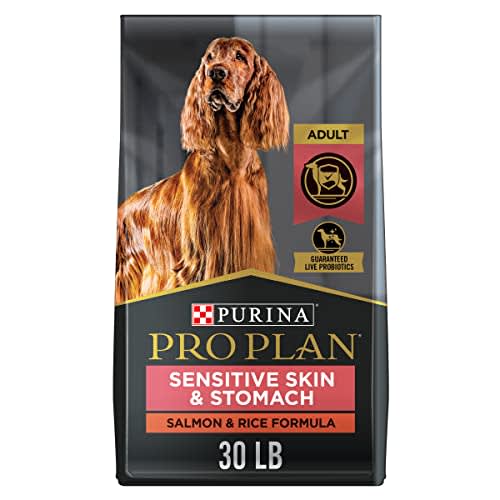As a dog owner, you want nothing but the best for your furry friend. One of the most important decisions you’ll make is what to feed them. With so many options on the market, it can be overwhelming to choose the best dried dog food for your beloved pet.
In this article, we’ll explore the top dried dog food brands and what makes them stand out. We’ll also discuss important factors to consider when selecting a dog food, such as your dog’s age, breed, and health needs. By the end, you’ll have all the information you need to make an informed decision and ensure your dog’s health and happiness.

Which Dried Dog Food is Best?
When it comes to feeding your furry companion, selecting the right food is critical. Dry dog food, also known as kibble, is a popular option for many dog owners. With so many varieties available in the market, choosing the best dried dog food can be overwhelming. Here we have compiled a comprehensive guide to help you choose the best dried dog food for your furry friend.
Ingredients
The first thing to consider when choosing dried dog food is the ingredients. The ingredients list should be the first thing you check before making a purchase. Look for foods that contain high-quality protein sources like chicken, lamb, fish, or beef. Avoid foods that contain animal by-products or fillers like corn, wheat, and soy, as they have little nutritional value and can cause digestive issues.
Another essential ingredient to look for is carbohydrates. Dogs need carbohydrates for energy, but not all carbohydrates are equal. Look for carbohydrates sources like sweet potatoes, brown rice, and peas. These ingredients are easy to digest and provide sustained energy.
When it comes to fats, look for foods that contain healthy fats like fish oil and flaxseed oil. These fats help to promote healthy skin and coat and support joint health.
Nutritional Value
The nutritional value of dried dog food is also an essential factor to consider. Look for foods that meet the minimum requirements for protein, fat, and carbohydrates. The Association of American Feed Control Officials (AAFCO) sets these standards. Foods that meet these standards will have a label stating that they are nutritionally complete and balanced.
When selecting dried dog food, pay attention to the calorie content. Overfeeding your dog can lead to obesity, which can cause several health issues. Choose a food that provides the right amount of calories for your dog’s age, weight, and activity level.
Brand Reputation
The reputation of the brand is also an essential factor to consider when selecting dried dog food. Look for brands that have a good reputation and have been in the market for a long time. These brands are more likely to have rigorous quality control standards and use high-quality ingredients.
Read reviews from other dog owners to see what they think about the brand. Also, check if the brand has had any product recalls in the past. Brands that have had product recalls should be avoided.
Texture and Flavor
Dogs can be picky eaters, so finding a food that your dog likes is essential. Dried dog food comes in different textures and flavors. Some dogs prefer crunchy kibble, while others prefer softer food. Experiment to find what your dog prefers.
If your dog has a sensitive stomach, look for foods that are specifically formulated for sensitive stomachs. These foods are easy to digest and contain ingredients that are less likely to cause digestive issues.
Price and Value
The price of dried dog food can vary significantly. While it may be tempting to choose the cheapest option, it’s important to remember that you get what you pay for. Cheap dog food may contain low-quality ingredients and fillers that offer little nutritional value.
Choose a food that offers good value for money. Look for foods that contain high-quality ingredients and meet your dog’s nutritional needs. While these foods may be more expensive, they will save you money in the long run by keeping your dog healthy and preventing health problems.
Wet vs. Dry Dog Food
Wet dog food is an alternative to dried dog food. Wet dog food comes in cans or pouches and contains a high moisture content. While wet dog food can be more appealing to some dogs, it has some downsides. Wet dog food can be more expensive than dried dog food, and it spoils quickly once opened.
Dried dog food, on the other hand, is more convenient and has a longer shelf life. It’s also easier to store and transport. Dried dog food can be left out for extended periods without spoiling, making it ideal for busy pet owners.
Grain-Free vs. Grain-Inclusive
Grain-free dog food has become increasingly popular in recent years. Grain-free dog food is made without grains like corn, wheat, and soy. While grain-free dog food may be beneficial for dogs with allergies, it’s not necessary for all dogs.
Grain-inclusive dog food provides a balanced diet and is generally more affordable than grain-free dog food. Unless your dog has a specific allergy or sensitivity to grains, grain-inclusive dog food is a good option.
Organic vs. Non-Organic
Organic dried dog food is made with ingredients that are grown without pesticides, synthetic fertilizers, or genetically modified organisms (GMOs). Organic dog food is more expensive than non-organic dog food, but it’s healthier and more natural.
Non-organic dog food is made with ingredients that may contain pesticides and synthetic fertilizers. While non-organic dog food is generally less expensive, it may not be as healthy as organic dog food.
Senior Dog Food
As dogs age, their nutritional needs change. Senior dog food is specifically formulated to meet the nutritional needs of older dogs. Senior dog food contains fewer calories and less fat than regular dog food, which helps to prevent obesity.
Senior dog food also contains ingredients that support joint health and promote brain function. Look for senior dog food with high-quality protein sources like chicken, lamb, or fish.
Puppy Food
Puppy food is specifically formulated to meet the nutritional needs of growing puppies. Puppy food contains higher levels of protein, fat, and carbohydrates than adult dog food. These nutrients support growth and development.
Puppy food also contains essential vitamins and minerals that promote healthy immune function and brain development. Look for puppy food that is specifically formulated for your puppy’s breed and size.
Conclusion
Choosing the best dried dog food for your furry friend can be overwhelming, but it doesn’t have to be. By considering the ingredients, nutritional value, brand reputation, texture and flavor, price and value, and other factors, you can choose a high-quality food that meets your dog’s nutritional needs.
Keep in mind that the best-dried dog food for your dog may not be the same as the best-dried dog food for another dog. Experiment to find what works best for your dog.
Frequently Asked Questions
Choosing the best dried dog food for your furry friend can be overwhelming. With so many options on the market, it can be difficult to determine which brand is the best for your dog’s needs. Below are five common questions regarding dried dog food and their answers to help you make an informed decision.
1. What ingredients should I look for in dried dog food?
When selecting dried dog food, it is important to look for high-quality protein sources like chicken, turkey, beef, or fish. Additionally, the food should contain healthy fats, whole grains, and vegetables. Avoid foods that contain fillers or by-products, as these can be harmful to your dog’s health.
Reading the ingredient list on the packaging can help you determine whether the food is high-quality or not. If you are unsure about a particular ingredient, consult with your veterinarian.
2. Is grain-free dried dog food better for my dog?
Grain-free dried dog food has become increasingly popular in recent years. However, it is important to note that not all dogs require a grain-free diet. In fact, grains like rice and oats can be a healthy source of carbohydrates for dogs.
If your dog has a grain allergy or sensitivities, then a grain-free diet may be necessary. However, if your dog does not have any issues with grains, there is no need to switch to a grain-free diet.
3. Should I choose a dried dog food based on my dog’s breed or size?
While there are some dried dog foods that are formulated specifically for certain breeds or sizes, it is not always necessary to choose a food based on these factors. Most high-quality dried dog foods will have the appropriate balance of nutrients to meet the needs of dogs of all sizes and breeds.
However, if your dog has specific health concerns or dietary needs, consult with your veterinarian to determine the best food for your dog.
4. How much dried dog food should I feed my dog?
The amount of dried dog food you should feed your dog will depend on their age, weight, and activity level. Most dog food packaging will provide a feeding guide to help you determine the appropriate amount of food for your dog.
It is important to monitor your dog’s weight and adjust their food intake as necessary. Overfeeding can lead to obesity and other health problems, while underfeeding can lead to malnutrition.
5. What are some high-quality dried dog food brands to consider?
There are many high-quality dried dog food brands on the market. Some popular options include Blue Buffalo, Orijen, Taste of the Wild, and Wellness. It is important to choose a brand that uses high-quality ingredients and has a good reputation for quality and safety.
Additionally, consult with your veterinarian to determine the best food for your dog’s specific needs.

In conclusion, choosing the best-dried dog food can be overwhelming. With so many brands and varieties on the market, it can be challenging to determine which one is the best for your furry friend. However, there are a few key factors to consider when making your decision.
Firstly, it’s essential to look for a brand that uses high-quality ingredients. You want to ensure that your dog’s food is made from real meat, vegetables, and fruits, without any fillers or artificial additives.
Secondly, consider your dog’s specific dietary needs. If your dog has allergies or sensitivities, look for a brand that offers limited ingredient options or is specifically formulated for sensitive stomachs.
Finally, don’t forget to read reviews and do your research before making a purchase. Other dog owners can provide valuable insight into the quality and effectiveness of different brands.
By taking these factors into consideration, you can make an informed decision and choose the best-dried dog food for your furry friend’s health and happiness.
